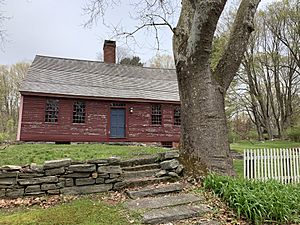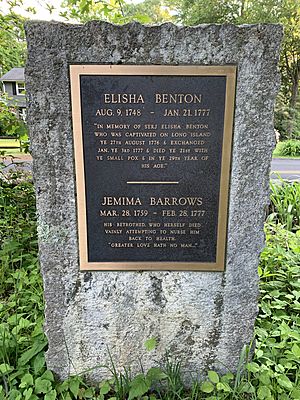Daniel Benton Homestead facts for kids

Daniel Benton Homestead
|
|
| Established | 1970 (house built in 1720) |
|---|---|
| Location | 154 Metcalf Road Tolland, Connecticut 06084 United States |
| Type | Historic house museum |
The Daniel Benton Homestead is a very old house in Tolland, Connecticut. It was built way back in 1720, making it the oldest house in town! Today, it's a historic house museum, which means you can visit it to learn about history. The Tolland Historical Society has been taking care of it as a museum since 1970.
This homestead is one of Tolland's four main historic places. The others are the Old Tolland County Jail and Museum, the Tolland County Courthouse, and the Hicks-Stearns Family Museum.
Contents
Exploring the Historic House
The Daniel Benton Homestead is a colonial-style house. It has ten rooms, five fireplaces, and a large cellar. The house has been carefully fixed up and painted in its original colors. The wood panels in the parlor (a formal living room) were painted to look like walnut wood. This was a popular style in early Georgian architecture.
A Look at the Homestead's History
The Benton Family Home
Daniel Benton built this house in 1720 on 40 acres of farmland. His father, Samuel Benton, was one of the first people to settle in Tolland. The house stayed in the Benton family for six generations, which means many generations of Bentons lived there. It was also the family home of William Benton, who became a U.S. Senator.
The American Revolutionary War
During the American Revolutionary War, something interesting happened in the house's cellar. Twenty Hessian soldiers were held there as prisoners. Hessians were German soldiers who fought for the British. To pass the time, they carved designs into the cellar's wooden beams. These carvings are now hard to see. The prisoners were treated well, and some even decided to stay in Tolland after they were set free.
The homestead was also the setting for a sad love story. Daniel Benton's grandson, Elisha Benton (born in 1748), fell in love with Jemima Barrows (born in 1759). She was 11 years younger than him and the daughter of a local cabinetmaker. Both families did not approve of their relationship because of the age difference and their different social backgrounds.
Elisha and two of his brothers joined the Continental Army to fight in the war. They were captured during the Battle of Long Island. For months, they were held on British prison ships, which were very unhealthy places. Sadly, Elisha's brothers died while they were prisoners.
Elisha was released in a prisoner exchange and came home in January 1777. He was very sick with smallpox, a serious disease. Jemima tried to help him get better, but Elisha died on January 21. Jemima also became sick and died of smallpox on February 28. At that time, it was not allowed to bury unmarried couples next to each other. So, Elisha and Jemima were buried a short distance apart on the Benton land.
The Homestead in the 1900s
In 1934, the Chapin family, who were related to the Bentons, sold the house. Florrie Bishop Bowering bought it. She was a radio host for WTIC and taught about diet at the University of Connecticut. Florrie Bowering fixed up the house and lived there until 1968.
Then, William Shocket and Charles Goodstein bought the house. On December 13, 1969, they gave the house, its land, and its furniture to the Tolland Historical Society. The house officially opened as a museum the next year. You can visit it for tours on Sundays from June through September.
Some people say the house is haunted by ghosts. They say they have seen the ghosts of Hessian soldiers and of the lovers, Elisha and Jemima. Florrie Bowering's maid once said she saw a young woman in a wedding dress walking through the house and crying. Other visitors have reported strange lights, sounds, and even seeing figures that weren't really there.
See also
 In Spanish: Hacienda de Daniel Benton para niños
In Spanish: Hacienda de Daniel Benton para niños


